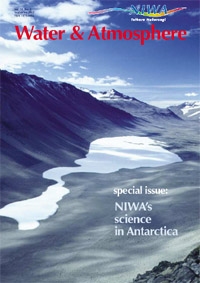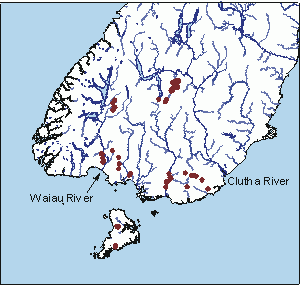
On this page
- Winter science at Scott Base
- Giant marine bloodsuckers
- New ocean current studies
- Environment Watch on CD
- Huge undersea avalanche
- A manager for the NIWA Marine Biology collection
Winter science at Scott Base
Though the amount of science done in Antarctica over the winter is generally limited by the dark and the cold, NIWA’s programme of remote sensing of stratospheric trace gases is one activity that continues through the winter. While some of the instruments are shut down for the winter darkness, others are able to carry on making measurements, usually with moonlight.
This year NIWA has had an extra involvement with a winter science project. Canterbury University PhD student Rebecca Batchelor has spent the winter at Scott Base extending the Fourier transform spectrometer measurements at Arrival Heights. Specifically she was making measurements with moonlight at a very long wavelength (3 µm), which contains an absorption signature of hydrogen chloride (HCl) in the stratosphere.

Hydrogen chloride is a stable reservoir of the chlorine that is in the stratosphere from man-made chemicals such as chlorofluorocarbons. During the winter this chlorine is converted to more active forms by chemical processes on the surface of polar stratospheric clouds, and the amount of HCl declines. In the springtime, sunlight drives the last step of the chain that leads to the rapid depletion of ozone. Removal of HCl calculated from Rebecca’s winter measurements will be compared to that expected from chemical models.
While in Antarctica, Rebecca has also helped out with other atmospheric science projects, such as the Italian aerosol lidar and the University of Wyoming balloon programme based at McMurdo Station. This collaboration looks likely to strengthen both her PhD work and NIWA’s collaborative links with these projects. Rebecca’s winter is now coming to a close as she will return to New Zealand in October, but September is an important period in which her lunar measurements can be directly compared with the more accurate solar measurements.
For further details contact: Stephen Wood or Rebecca Batchelor NIWA Lauder, Private Bag 50 061, Omakau, Central Otago Phone +64 3 440 0055, Fax +64 3 447 3348 [email protected] or [email protected]

Giant marine bloodsuckers

Imagine being bitten by a mosquito as big as your thumb. The marine equivalent of just such an animal has been discovered on recent research expeditions by NIWA’s vessel Tangaroa, among hundreds of new marine species collected from around New Zealand.
These huge-eyed isopod crustaceans (family Aegidae) are large “micro-predators”, up to 7 cm long. They feed much like mosquitoes and midges, by grabbing the target prey such as fishes and sharks, taking a blood meal and then moving off.
Humans, thin-skinned and lacking scales, would seem to be a suitable prey item for these blood-sucking crustaceans, and attacks are known in the tropical Caribbean. Fortunately for New Zealanders, these creatures live well below surface waters and we can swim without fear of being pounced on for a quick meal.
A monograph on these isopod crustaceans (closely related to the smaller, familiar and rather innocuous pill bugs or wood lice of suburban gardens) is in preparation. New Zealand has 35–40 species. All but one are new records and 20 of the species are new to science.
These new finds indicate that New Zealand waters could harbour the greatest species diversity of these animals in the world.
The high number of new species and new records in our collections of these large isopod crustaceans highlights the success of recent NIWA biodiversity sampling.
Biodiversity samples have been collected in joint voyages to Chatham Rise, Campbell Plateau and northern sea mounts by several FRST and MFishfunded research programmes (“Ocean Ecosystems” – organised by Scott Nodder; “Earth– Ocean Change” – Helen Neil; “Seamounts” – Malcolm Clark and Ashley Rowden). Most recently we have received specimens from the joint New Zealand–Australian NORFANZ expedition to the eastern Tasman Sea led by Clive Roberts (Te Papa Tongarewa) and Malcolm Clark (NIWA).
For further information contact: Niel Bruce NIWA, Private Bag 14901, Kilbirnie, Wellington Phone +64 4 386 0300, Fax +64 4 386 2153 [email protected]

New ocean current studies
In July crew and scientists travelled north on the NIWA vessel Tangaroa to search for answers as to how the Tasman Front, a band of eastward-flowing water near 32°S, links to the flows along the east and west coasts of the North Island of New Zealand. En route to the eastern Pacific, the warm subtropical water of the Tasman Front must flow over the huge undersea mountain ranges around New Zealand. The largest submarine ridges, the Lord Howe Rise and the Norfolk Ridge, affect the flow all the way to the surface, much like mountain ranges on land guide the winds above them. The tall peaks of the Norfolk Ridge channel most of the warm water through a gap south of Norfolk Island into the Norfolk Basin. This flow provides much of the subtropical inflow for the warm currents along the eastern New Zealand coast.
The Tangaroa survey revealed that currents of 1 knot, or nearly 2 kilometres per hour, were flowing through the gap before turning south-east along an undersea cliff towards Cape Reinga. We placed five moorings across the gap, spanning depths of up to 1.5 kilometres, to monitor the transport and its variation over the coming year.

On the same voyage we deployed another array of moorings on New Zealand’s north-west shelf, offshore off Hokianga, to measure the current along that coast. Of all the currents around the New Zealand coast, this is perhaps the least known. Only a few measurements have ever been made of it. Its connection to other currents around New Zealand, or those farther west in the Tasman Sea, is as yet unknown.
Together with on-going measurements in the East Auckland Current, the measurements from the Tangaroa voyage will provide new information about the subtropical influence on the currents along both coasts of New Zealand.
For further information, contact: Melissa Bowen NIWA, Private Bag 14901, Kilbirnie, Wellington Phone +64 4 386 0300, Fax +64 4 386 2153 [email protected]

Environment Watch on CD: Promoting healthy farm and forest streams
Six Environment Watch CDs are now available from NIWA (Information Series No 37-42). These educational resources are intended for use by community groups, environmental educators, and secondary schools. NIWA has produced the series based on video clips and web pages developed as Environment Watch segments from the TV3 programme No8 Wired, produced by the Gibson Group. Topics covered on the CDs are: (1) Forestry and streams; (2) Dairy shed waste, bad bugs and SHMAK Monitoring tools; (3) Weeds in streams; (4) Farm stream fisheries; (5) Sustainable farming projects; and (6) Researching sustainable farming practices to protect waterways. The CDs include student worksheets for each topic and identify relevant objectives in the New Zealand secondary school curriculum.
Sets of CDs have been provided free of charge to all New Zealand secondary schools and to a range of education/farm advisory agencies. Additional sets are available for purchase by those not affiliated with a school or education/farm advisory agency at the nominal price of $30 per set of six CDs.
More information and order forms.

Huge undersea avalanche dwarfs New Zealand’s biggest landslide
NIWA scientists have just returned from a survey of a huge undersea avalanche off the east coast of New Zealand onboard the research vessel Tangaroa.
The volume of material in the Matakaoa submarine avalanche, which occurred about 30,000 years ago, is 650 km3. In contrast, one of the world’s biggest onshore landslides occurred in Fiordland, but it had a volume of only 30 to 35 km3.

This undersea avalanche is near the giant Ruatoria avalanche in which a piece of the seabed as big as the Coromandel Peninsula tumbled 50 km across the ocean floor about 170,000 years ago.
Data collected on this latest research voyage from the site of the Matakaoa avalanche show that during the Quaternary (the last 1.8 million years) the Waiapu River has been dumping enormous amounts of mud on the sea floor. This may have been the major contributor to the collapse of the continental shelf margin into the Matakaoa avalanche, which extended some 200 km north of East Cape.
Studies such as these will help geologists find out what triggers these avalanches and what the likely risk is from hazards such as tsunamis. What is needed is a more precise idea of the timing of the most recent events so we can estimate their recurrence. It will then be possible to assess what the risks are to people living close to the east coast.
For further information contact: Dr Geoffroy Lamarche NIWA, PO Box 14901, Kilbirnie, Wellington Phone+64 4 386 0300, Fax 04 386 2153 [email protected]

A manager for the NIWA Marine Biology collection
Anyone involved in studies of biodiversity, taxonomy, or simply identification of plants and animals will appreciate the importance of reference collections of specimens and their careful management. NIWA’s growing collection of marine organisms (held in Wellington) is now managed by Anne-Nina Lörz, who joined our Marine Biodiversity and Biosecurity group in May. Previously Anne was based at the Zoological Museum, Hamburg, and was recently awarded a PhD by the University of Hamburg for her study on the taxonomy, ecology and phylogeny of Antarctic amphipods. Anne has substantial experience in polar marine fieldwork having participated in one expedition to Greenland and two to Antarctica, the latter two on board the German research vessel Polastern.
Anne’s first priority is to set up an electronic registration system that will simplify collection management and organisation. The Marine Biology collection comprises about 100,000 lots and several million specimens accumulated since 1961. The majority of specimens come from within the New Zealand EEZ, but there is a significant amount of material from Norfolk and Macquarie Islands, seamounts, Antarctica and the Pacific Islands.
For further information about the collection contact: Dr Anne-Nina Lörz NIWA, PO Box 14901, Kilbirnie, Wellington Phone+64 4 386 0300, Fax 04 386 2153 [email protected]
